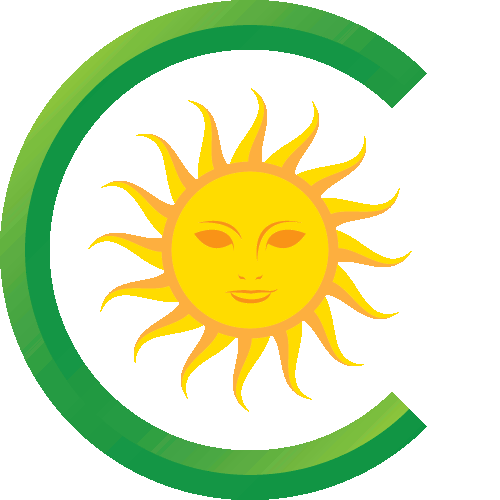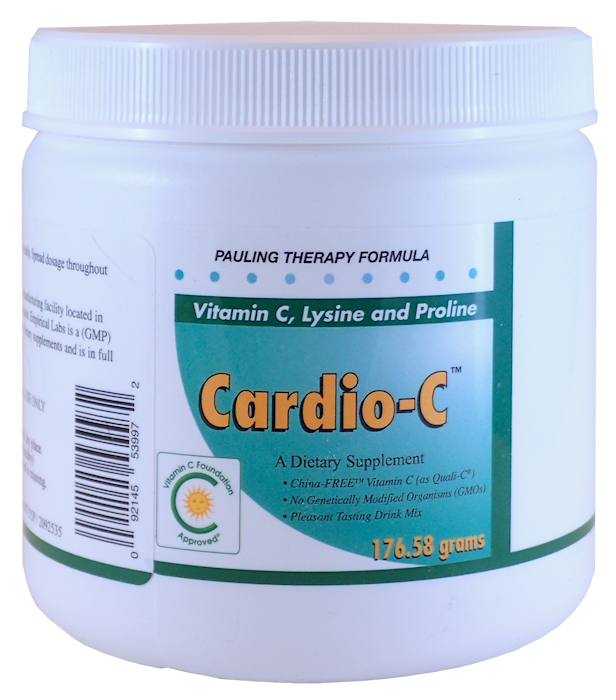 Pauling-THERAPY™
Pauling-THERAPY™
 Owen Fonorow coined the phrase Pauling-THERAPY™ in 1994 to
help distinguish products that provide the large dosages (i.e., at
least the 5,000 milligrams) of vitamin C and lysine, that were
specifically recommended by Linus Pauling.
Owen Fonorow coined the phrase Pauling-THERAPY™ in 1994 to
help distinguish products that provide the large dosages (i.e., at
least the 5,000 milligrams) of vitamin C and lysine, that were
specifically recommended by Linus Pauling.

This potent formula includes proline and is the only Vitamin C Foundation Approved® Pauling-therapy™ drink mix.
About Cardio-C™

Or you may place orders and ask questions by phone: 800-894-9025 (USA).
 Your purchase supports the nonprofit
Foundation.
Your purchase supports the nonprofit
Foundation.
What is the Pauling Therapy?

By 1994, Linus Pauling and associates had informed the world that non prescription substances, they called "Lp(a) binding inhibitors," prevent cardiovascular disease and will destroy existing atherosclerotic plaque. Pauling's rationale explains why the Lp(a) binding inhibitors, vitamin C, together with the essential amino acid lysine, exert such a strong anti-CVD effect inside human arteries.
These substances diminish extracellular growth which, if left unchecked, narrow the arteries, decreases blood flow and increases the chance of heart attack or stroke.
After Linus Pauling learned that Lp(a) cholesterol binds to strands of lysine protruding from weak and damaged blood vessels, Pauling invented the high-lysine therapy, saying:
 Owen Fonorow coined Pauling-THERAPY™ to stand
for sufficiently large dosages of vitamin C and lysine, (i.e., at least
the 5,000 milligrams) specifically recommended by Linus Pauling. While
it is true that Linus Pauling and Matthias Rath together patented these
dietary supplements as Lp(a) Binding Inhibitors,
when this term was first coined,
Dr. Rath's products did not contain the higher dosages
recommended by Linus Pauling on the Unified Theory Video.
Owen Fonorow coined Pauling-THERAPY™ to stand
for sufficiently large dosages of vitamin C and lysine, (i.e., at least
the 5,000 milligrams) specifically recommended by Linus Pauling. While
it is true that Linus Pauling and Matthias Rath together patented these
dietary supplements as Lp(a) Binding Inhibitors,
when this term was first coined,
Dr. Rath's products did not contain the higher dosages
recommended by Linus Pauling on the Unified Theory Video.
Review of the Science
According to Pauling, the Lp(a) binding inhibitor effect is two-pronged:
- Vitamin C and lysine stimulate the production of collagen.
An increased supply of collagen prevents the onset or spread of
cardiovascular disease by making arteries stronger,
and by preventing and healing arterial lesions that are caused by normal wear and tear.
- Lp(a) binding inhibitors may reverse atherosclerosis by inactivating the affinity that Lp(a) cholesterol has for the amino acid lysine. The second action of binding inhibitors disrupts the formation of the plaque.
Read more on the scientific underpinning for Pauling's theory and therapy
Vitamin C Foundation Approved Pauling-THERAPY™: Cardio-C™ one jar daily provides Linus Pauling's specific dosage recommendations for those without heart disease, and 2 or more servings daily provides Pauling's therapeutic dosages for stopping and reversing cardiovascular disease.
 The Pauling/Rath unified theory of cardiovascular disease (CVD)
constitutes one of the most promising breakthroughs in modern
science;[] yet its intriguing prediction, that the Lp(a) binding inhibitors
vitamin C and lysine will prevent and dissolve arterial blockages, has
been ignored, even suppressed, by the pharmaceutical industry, the
medical profession and the national
media.[]
The Pauling/Rath unified theory of cardiovascular disease (CVD)
constitutes one of the most promising breakthroughs in modern
science;[] yet its intriguing prediction, that the Lp(a) binding inhibitors
vitamin C and lysine will prevent and dissolve arterial blockages, has
been ignored, even suppressed, by the pharmaceutical industry, the
medical profession and the national
media.[] 
However, the public is slowly becoming informed via the Internet.[] The number of seemingly miraculous reversals of incapacitated cardiovascular diseased patients increases daily.[] The first three such accounts are depicted by Linus Pauling on video.[]
Linus Pauling stated that he doubted a double-blind, placebo controlled trial was necessary because the vitamin and amino acid therapy is non toxic, its effect is so pronounced, and CVD is otherwise debilitating or fatal.
These statements have not been evaluated by the Food and Drug Administration. This product is not intended to diagnose, treat, cure, or prevent any disease.
Scientific Basis for the Pauling/Rath Theory
 Cardiovascular related health problems comprise one-half of all causes
of death in the USA.
Cardiovascular related health problems comprise one-half of all causes
of death in the USA.
After Linus Pauling wrote his first best seller on vitamin C (Vitamin C, The Common Cold and the Flu) in 1970, vitamin C intake in the USA rose over 300% and the mortality from cardiovascular disease dropped by almost 40%.
In 1994 Linus Pauling, Ph.D., and his associate Matthias Rath, MD, patented Lp(a) Binding Inhibitors for the prevention and reversal of common cardiovascular disease caused by a sub-clinical vitamin C deficiency (chronic scurvy).
Pauling/Rath Patents
- 5,278,189 - Prevention and Treatment of Cardiovascular Disease with Ascorbate and Substances that Inhibit the Binding of Lipoprotein(a)
- 5,230,996 - Use of Ascorbate and (Lysine) for Organ and Blood Vessel Treatment Prior to Transplantation.
- 5,650,418 - Therapeutic Lysine Salt Composition and Method of Use
Previously, these two scientists had long advocated high-dose vitamin C treatment, and they had published their Unified Theory as to the root cause and proper treatment for all forms of cardiovascular disease, including congestive heart failure, heart disease and stroke.
Lp(a) is a low density lipoprotein cholesterol molecule. Dr. Rath was a member of a German medical team that in 1989 first determined that human atherosclerotic plaques are composed of Lp(a), not ordinary LDL (the so-called bad) cholesterol.[]
This finding led to hundreds of studies that strongly implicate Lp(a) as a primary risk factor in atherosclerosis, a narrowing of arteries that leads to the most common form of heart disease.
Vitamin C is irreplaceable during the human body's production of collagen. Collagen is a protein comprised of coiled lysine and proline fibers forming a helix which increases the tensile strength of blood vessels and other tissue. When the body produces ample collagen, arteries remain healthy, strong and resilient.
A lack of collagen (caused by chronic vitamin C deficiency) leads to weak arteries that become susceptible to the effects of wear and injury.
Acute scurvy, the specific vitamin C deficiency disease that kills, is the result of a general breakdown of tissue caused by the lack of collagen.
The Canadian G. C. Willis first suggested in 1952 that plaques form as arteries wear out. In 1989, it was discovered that the body attempts to heal microscopic arterial injuries, called lesions, by producing Lp(a), a sticky molecule with lysine-binding receptors. The Pauling/Rath unified theory identifies Lp(a) as a vitamin C surrogate: The Lp(a) molecule provides stability to arteries in the absence of collagen.
Scientists have determined that lysine and proline residue, from broken collagen strands at the site of the lesion, attract Lp(a). These "sticky" molecules can form a scab in the fast-moving blood stream. More Lp(a) is attracted to the ever- expanding "blockage" as the atherosclerotic plaque grows.
In theory, healthy arteries are strong and do not have exposed lysine and proline residue and will not attract Lp(a) or form plaques.
Mega-doses of specific nutrients prevent the spread of CVD, and may reverse atherosclerosis. Vitamin C combined with the amino acids lysine and proline create what Pauling and Rath called Lp(a) binding inhibitors. These low-cost, nontoxic substances prevent existing plaques from enlarging because they inactivate the Lp(a) molecule's affinity for lysine.
According to Nobel chemist Linus Pauling, the Lp(a) binding inhibitors are solvents that may "destroy existing atherosclerotic plaque."
Linus Pauling made specific and carefully considered dosage-recommendations, aka the Pauling-Therapy™. A dietary supplement must provide these nutrients at dosages much larger than ordinary vitamins in order to react as an Lp(a) binding inhibitor. At the proper high doses, Lp(a) binding inhibitors become the "Pauling Therapy" in honor of Pauling's contribution.
Pharmacology professor Steve Hickey, Ph.D., co-author of Ascorbate: The Science of Vitamin C, states that over the past 50 years the medical profession has failed to produce the required experiments that may dispute Pauling's assertions.
There are several nutritional substances that reduce Lp(a) blood levels. Vitamin C and vitamin B3 (Niacin) will lower Lp(a) 15-30% in one month. Recent research has shown that carnitine can also lower Lp(a).
Alternative medical doctors have reported that the amino acid proline lowers Lp(a) significantly over a period from six months to 18 months.
Common cholesterol-lowering drugs called statins are known to elevate serum Lp(a). Advertisements for statin medications in Canadian medical journals must carry this warning.[]
Impressive Results
Testimonials
Interest in the Pauling therapy grows due to the increasing number of favorable accounts of CVD reversals.
Dear Owen Fonorow,
I want to thank you for saving my life!
It was articles written by you that were published in the "Townsend Letters" ten years ago, when you described the Linus Pauling protocols regarding cardio-vascular disease. In 2002, I began following Dr. Pauling's recommendations and continue until today with the results recorded in the attached medical records.
I feel indebted to you, Dr. Fonorow, for providing me with information that has enabled me to live the last ten years of my life in excellent health. Thank you for keeping Linus Pauling's legacy alive.
If the information contained in the enclosed (13 year & experience with Lp(a)) can be of benefit to your cause, you have my permission to use said information, in any manner, shape, or form, with no strings attached.
Thank you sincerely,
Dave G. Cramer
(a humble 84 year old follower & believer)
These statements have not been evaluated by the Food and Drug Administration. This product is not intended to diagnose, treat, cure, or prevent any disease.
The first reports came from Linus Pauling himself (circa 1989). These were published and are presented as part of the Linus Pauling video on Heart Disease: A Unified Theory of Cause and Cure. During this video, Linus Pauling himself depicts the first use of his invention, the seemingly miraculous reversals of incapacitated CVD patients.
The Pauling video lecture contains additional information for health professionals and may be obtained on-line, or by telephoning 800-894-9025, or 1-312-888-5117 outside the USA.
Several Lp(a) Binding Inhibitor formulas as dietary supplements are now available without prescription.
Many of the following detailed first-hand testimonials may be found at Owen's Book web site
Still more testimony is posted at PaulingTherapy.com.[]
The Pauling Story Behind the Cure for Heart Disease
He said, Dr. Pauling, " I have heart disease. My brother, my father both died of heart attacks. I am a biochemist but I was retired from the National Institutes of Health several years ago for disability because of my heart. I have had 3 by-pass operations, and I can't have any more by-pass operations. I like to walk, but I have trouble. After I have walked a little way I develop angina pectoris pain in my heart. If I take a nitroglycerin tablet, I can walk a little farther, and then I may have to take another nitroglycerin tablet."
He went on to say," I have been taking vitamin C, 5 grams a day for several years because of your recommendation. Is there something else that I could do that would permit me to walk?"
I said, "I could make a suggestion, it has never been tried before. Take Lysine. "
Well I didn't need to tell him what Lysine was, that it's an essential amino acid and you have to get around a gram a day to be in good health, and you get it in your foods, because he is one of the most distinguished biochemists in the United States, recipient of the National Medal of Science in the United States. So he said, how much shall I take? I thought, what do I know. I know that people get a gram or two in their food depending upon how much meat and fish they eat, that it's essential they have to get around one gram. It hasn't any known toxicity in animals or human beings.
I said 5 grams, 5 grams a day. He thanked me.
A couple of months later he telephoned me and said its almost miraculous. I started taking a gram a day and 2 grams and so on. Within a month after I had reached 5 grams a day of Lysine in addition to my 5 grams of vitamin C, I could walk 2 miles without any nitroglycerin tablets or without any pain in the chest. He said he had cut down the amount of heart medicine he was taking in half. "It's almost miraculous," he said.
Another couple of months went by and he telephoned me and said that, "I was feeling so good the other day that I cut down a big tree in our yard, and was chopping it up for wood, and I was also painting the house, and I got chest pains", despite his 5 grams of lysine, so he said that he "went up to 6 grams of lysine and 6 grams of vitamin C and told me now "I am continuing chopping down, chopping up the tree and painting the house". And now a couple of years later he is still in fine health. -- Linus Pauling [1993 Linus Pauling Video on Heart Disease]
Articles of Interest
- Official Pauling Therapy Web Site: PaulingTherapy.com
- Owen's Pauling Therapy Handbook Amazon best seller.
- CHRONIC SCURVY The Suppression of the Real Nature, Cause and Outright Cure for Heart Disease ... by Owen Fonorow
- The Cure For Heart Disease Treatment Protocol (Collected by Owen Fonorow)
- The Cure For Heart Disease Condensed Short Paper by Owen Fonorow
- Cardio-C Product Web Site
- Compare Cardio-C and Tower HeartTechnology
"If the claims for vitamin C are correct, it might replace many lucrative and expensive medications. As they researched their book ASCORBATE, Hickey and Roberts began to wonder if Pauling's offense had been to discuss openly the properties of a substance that threatens the profitability of medicine."
